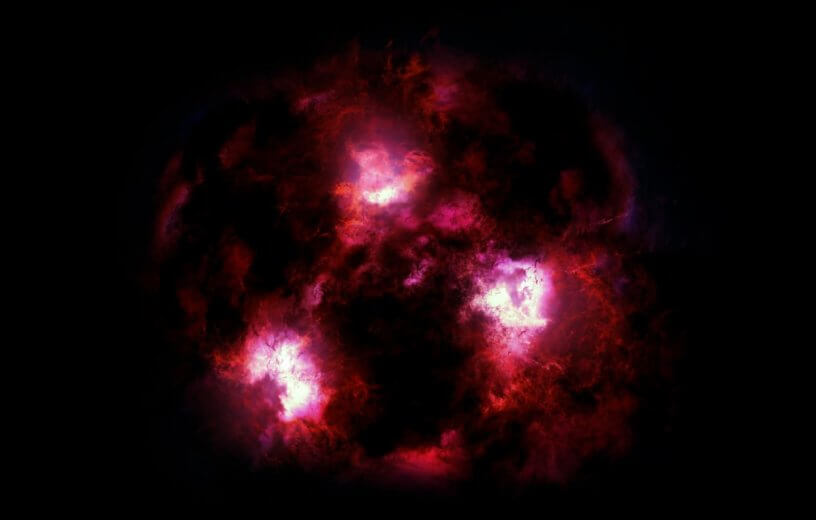TUCSON, Ariz. — For decades, astronomers have regarded hypotheses of supermassive galaxies hiding just out of sight as folklore. These fabled galaxies were often referred to as “cosmic Yetis” because there didn’t appear to be any real evidence of their existence, until now. Astronomers in the U.S. and Australia have captured the first-ever picture of one of the largest galaxies in the universe — and it all happened by accident!
This discovery provides groundbreaking new insight into the beginnings of our universe as a whole.
Christina Williams, the study’s lead author and a National Science Foundation postdoctoral fellow at the Steward Observatory at the University of Arizona, noticed a faint light blob while using the Atacama Large Millimeter Array (ALMA), a series of 66 radio telescopes positioned in the Chilean mountains. At first, Williams had no idea where the reading was emanating from.
“It was very mysterious because the light seemed not to be linked to any known galaxy at all,” says Williams in a media release. “When I saw this galaxy was invisible at any other wavelength, I got really excited because it meant that it was probably really far away and hidden by clouds of dust.”
Researchers estimate that it took the light signal 12.5 billion years to reach Earth, providing a view of the universe in its infancy immediately following the Big Bang. They theorize the observed light emission was caused by the warm glow of dust particles heated by stars being formed in a young galaxy; the dust clouds blocked out the light from the stars, making the galaxy virtually invisible until this faint emission was able to break through the dust.
“We figured out that the galaxy is actually a massive monster galaxy with as many stars as our Milky Way, but brimming with activity, forming new stars at 100 times the rate of our own galaxy,” comments study co-author Ivo Labbé.
According to the research team, this discovery could answer a long-standing astronomical quandary. Recent studies of extremely remote galaxies showed that, in the young universe, some of the biggest galaxies “matured” very quickly — an observation that has largely puzzled the astronomy community. These supermassive galaxies appeared to already be fully formed despite the fact that their light signals are estimated to be coming from a time when our universe was still very young (10% of its current age). Furthermore, astronomers never seem to be able to find these galaxies as they form; they seem to just pop up or make themselves visible out of nowhere randomly.
Smaller galaxies have also been observed in the early universe using the Hubble Space Telescope, but these galaxies just aren’t growing fast enough to provide an answer to astronomers’ questions regarding these remote, seemingly instantly mature galaxies.
“Our hidden monster galaxy has precisely the right ingredients to be that missing link,” Williams explains, “because they are probably a lot more common.”
Willams and her team don’t know how many of these cosmic Yetis are out there, but they say the 2021 launch of the James Webb Space Telescope could allow them to peer through the dust shrouds and get a clearer picture of these lurking leviathans.
“JWST will be able to look through the dust veil so we can learn how big these galaxies really are and how fast they are growing, to better understand why models fail in explaining them,” Williams concludes.

The study is published in the Astrophysical Journal.

If Astronomer’s found it , why don’t they post a picture of it instead of some artists rendition? Food for thought. Did they really discover it . 🤔